BSBHRM602 Manage Human Resources Strategic Planning Homework Help
VerifiedAdded on 2023/06/12
|57
|10077
|341
Homework Assignment
AI Summary
This document presents a student's solution to the BSBHRM602 Manage Human Resources Strategic Planning assignment. It includes an overview of the assessment criteria, elements for competency demonstration, performance evidence, foundation skills, knowledge evidence, and assessment conditions. The solution also features observation and demonstration checklists to assess the learner's ability to research planning requirements, develop a human resource strategic plan, and implement the plan, along with essential skills like reading, writing, oral communication, and numeracy. The document also contains assessment tool definitions, explaining the purpose and use of learner workbooks, observations, major activities, skills and knowledge activities, third-party reports, case studies, learner guides, and evidence documents within the assessment process. Desklib offers a range of similar resources to aid students in their studies.
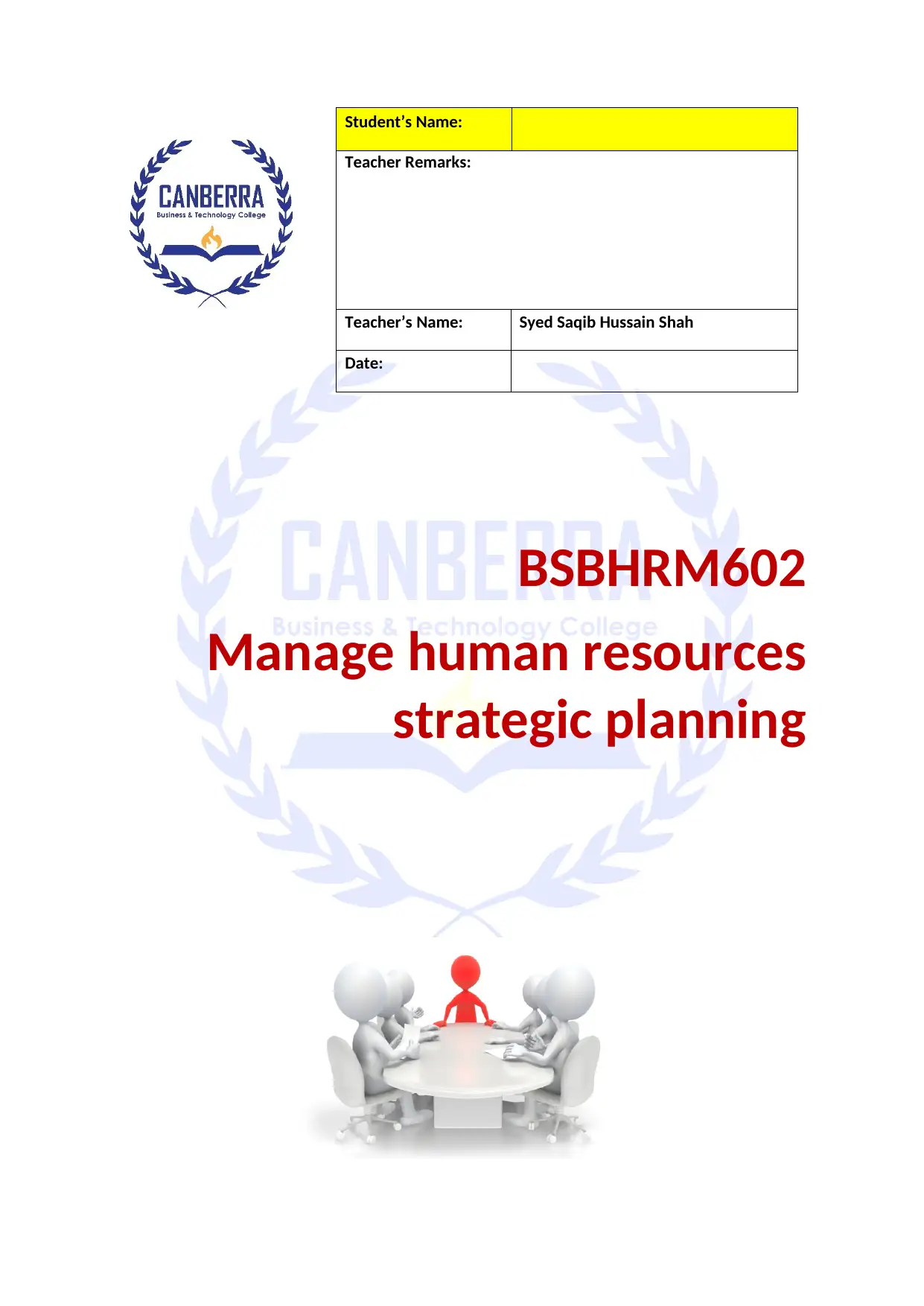
BSBHRM602
Manage human resources
strategic planning
Student’s Name:
Teacher Remarks:
Teacher’s Name: Syed Saqib Hussain Shah
Date:
Manage human resources
strategic planning
Student’s Name:
Teacher Remarks:
Teacher’s Name: Syed Saqib Hussain Shah
Date:
Paraphrase This Document
Need a fresh take? Get an instant paraphrase of this document with our AI Paraphraser
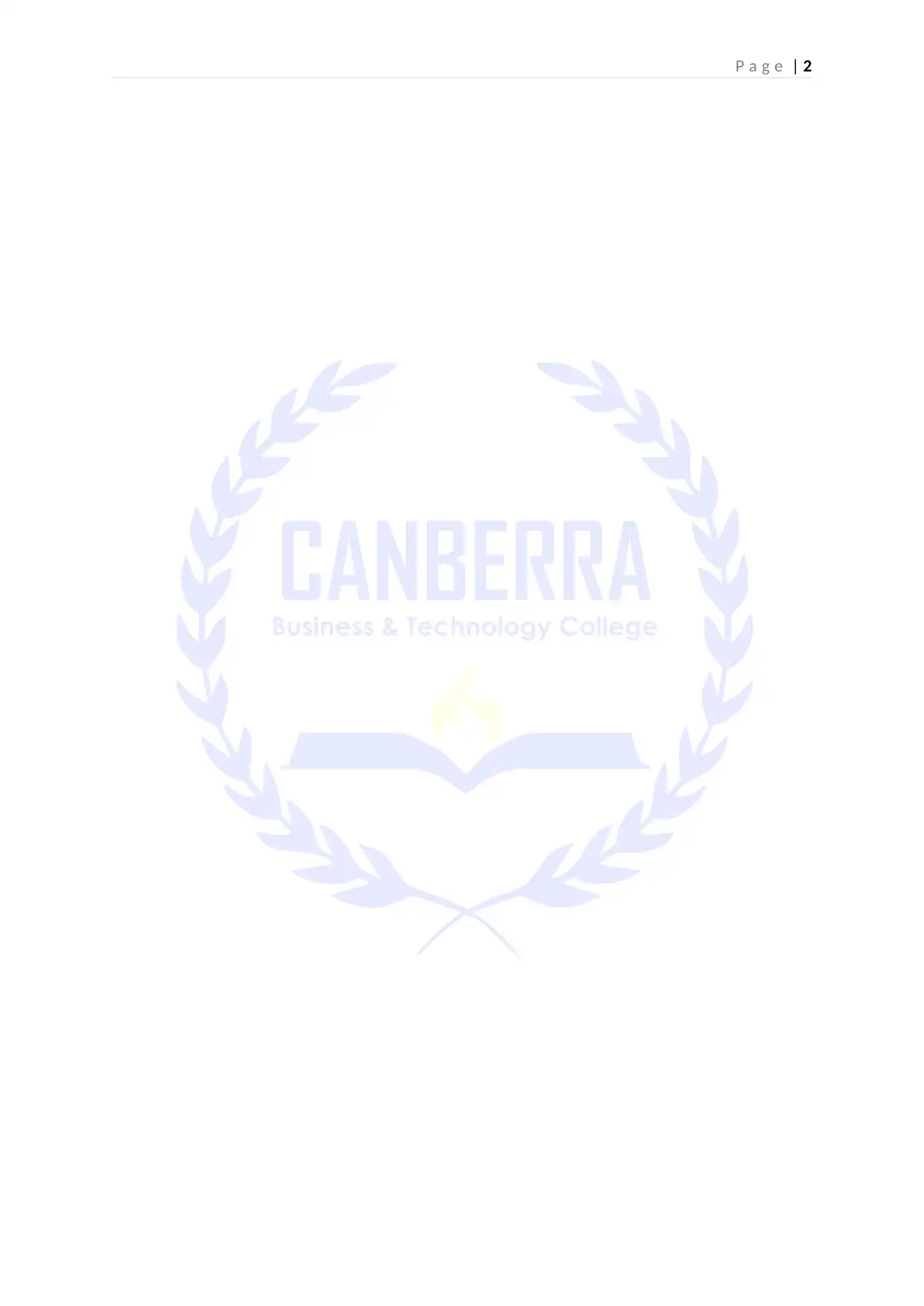
P a g e | 2
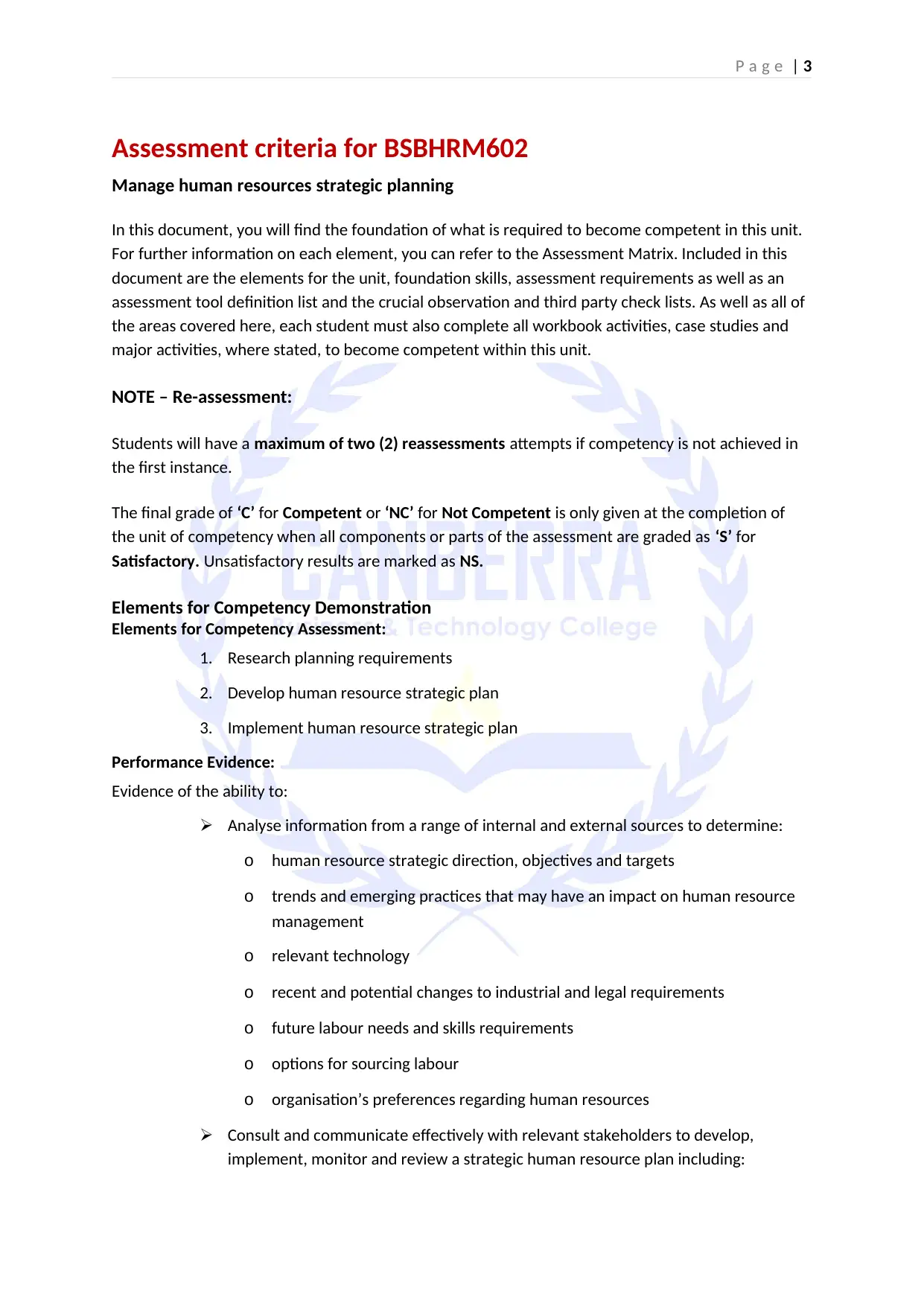
P a g e | 3
Assessment criteria for BSBHRM602
Manage human resources strategic planning
In this document, you will find the foundation of what is required to become competent in this unit.
For further information on each element, you can refer to the Assessment Matrix. Included in this
document are the elements for the unit, foundation skills, assessment requirements as well as an
assessment tool definition list and the crucial observation and third party check lists. As well as all of
the areas covered here, each student must also complete all workbook activities, case studies and
major activities, where stated, to become competent within this unit.
NOTE – Re-assessment:
Students will have a maximum of two (2) reassessments attempts if competency is not achieved in
the first instance.
The final grade of ‘C’ for Competent or ‘NC’ for Not Competent is only given at the completion of
the unit of competency when all components or parts of the assessment are graded as ‘S’ for
Satisfactory. Unsatisfactory results are marked as NS.
Elements for Competency Demonstration
Elements for Competency Assessment:
1. Research planning requirements
2. Develop human resource strategic plan
3. Implement human resource strategic plan
Performance Evidence:
Evidence of the ability to:
Analyse information from a range of internal and external sources to determine:
o human resource strategic direction, objectives and targets
o trends and emerging practices that may have an impact on human resource
management
o relevant technology
o recent and potential changes to industrial and legal requirements
o future labour needs and skills requirements
o options for sourcing labour
o organisation’s preferences regarding human resources
Consult and communicate effectively with relevant stakeholders to develop,
implement, monitor and review a strategic human resource plan including:
Assessment criteria for BSBHRM602
Manage human resources strategic planning
In this document, you will find the foundation of what is required to become competent in this unit.
For further information on each element, you can refer to the Assessment Matrix. Included in this
document are the elements for the unit, foundation skills, assessment requirements as well as an
assessment tool definition list and the crucial observation and third party check lists. As well as all of
the areas covered here, each student must also complete all workbook activities, case studies and
major activities, where stated, to become competent within this unit.
NOTE – Re-assessment:
Students will have a maximum of two (2) reassessments attempts if competency is not achieved in
the first instance.
The final grade of ‘C’ for Competent or ‘NC’ for Not Competent is only given at the completion of
the unit of competency when all components or parts of the assessment are graded as ‘S’ for
Satisfactory. Unsatisfactory results are marked as NS.
Elements for Competency Demonstration
Elements for Competency Assessment:
1. Research planning requirements
2. Develop human resource strategic plan
3. Implement human resource strategic plan
Performance Evidence:
Evidence of the ability to:
Analyse information from a range of internal and external sources to determine:
o human resource strategic direction, objectives and targets
o trends and emerging practices that may have an impact on human resource
management
o relevant technology
o recent and potential changes to industrial and legal requirements
o future labour needs and skills requirements
o options for sourcing labour
o organisation’s preferences regarding human resources
Consult and communicate effectively with relevant stakeholders to develop,
implement, monitor and review a strategic human resource plan including:
⊘ This is a preview!⊘
Do you want full access?
Subscribe today to unlock all pages.

Trusted by 1+ million students worldwide
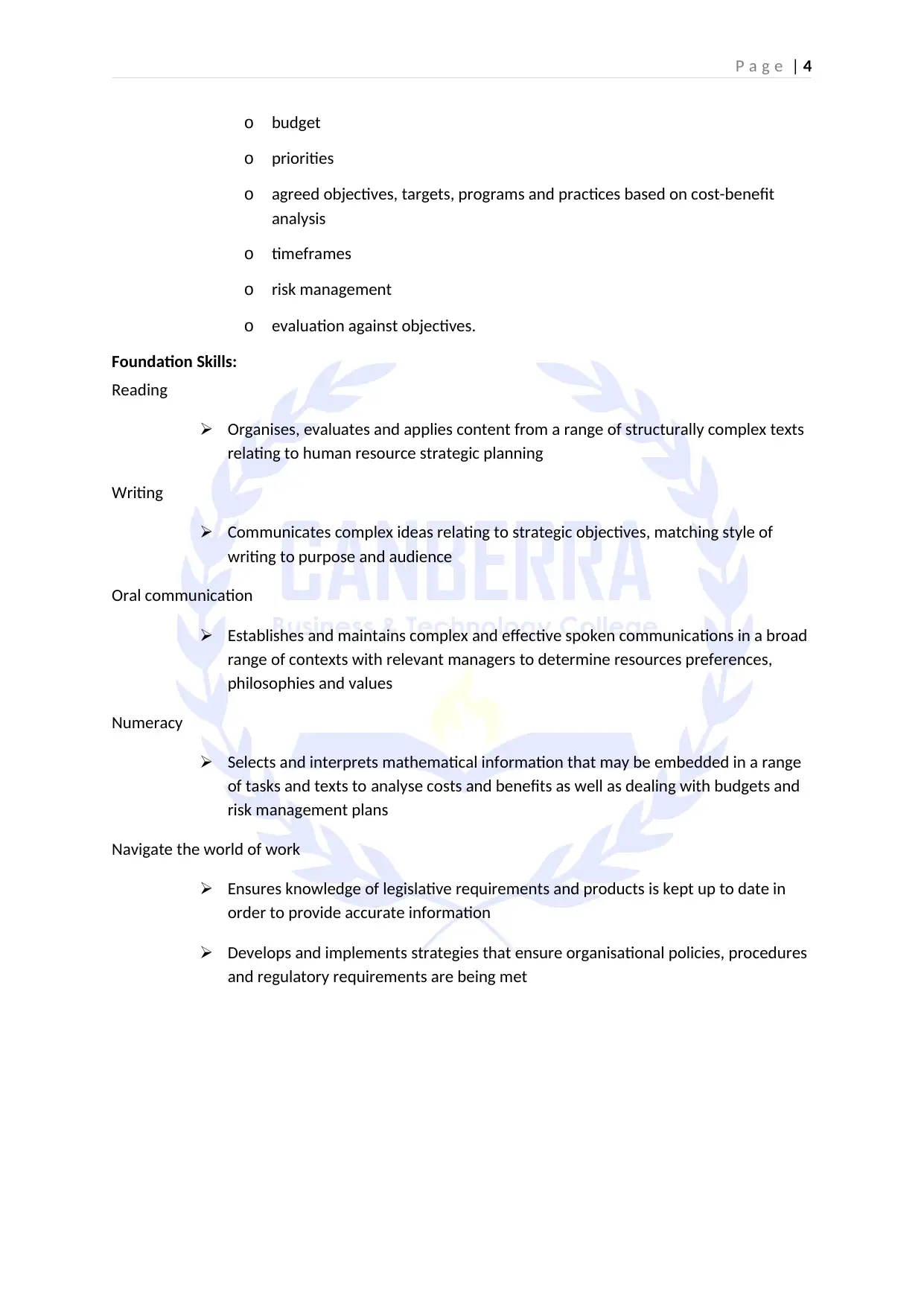
P a g e | 4
o budget
o priorities
o agreed objectives, targets, programs and practices based on cost-benefit
analysis
o timeframes
o risk management
o evaluation against objectives.
Foundation Skills:
Reading
Organises, evaluates and applies content from a range of structurally complex texts
relating to human resource strategic planning
Writing
Communicates complex ideas relating to strategic objectives, matching style of
writing to purpose and audience
Oral communication
Establishes and maintains complex and effective spoken communications in a broad
range of contexts with relevant managers to determine resources preferences,
philosophies and values
Numeracy
Selects and interprets mathematical information that may be embedded in a range
of tasks and texts to analyse costs and benefits as well as dealing with budgets and
risk management plans
Navigate the world of work
Ensures knowledge of legislative requirements and products is kept up to date in
order to provide accurate information
Develops and implements strategies that ensure organisational policies, procedures
and regulatory requirements are being met
o budget
o priorities
o agreed objectives, targets, programs and practices based on cost-benefit
analysis
o timeframes
o risk management
o evaluation against objectives.
Foundation Skills:
Reading
Organises, evaluates and applies content from a range of structurally complex texts
relating to human resource strategic planning
Writing
Communicates complex ideas relating to strategic objectives, matching style of
writing to purpose and audience
Oral communication
Establishes and maintains complex and effective spoken communications in a broad
range of contexts with relevant managers to determine resources preferences,
philosophies and values
Numeracy
Selects and interprets mathematical information that may be embedded in a range
of tasks and texts to analyse costs and benefits as well as dealing with budgets and
risk management plans
Navigate the world of work
Ensures knowledge of legislative requirements and products is kept up to date in
order to provide accurate information
Develops and implements strategies that ensure organisational policies, procedures
and regulatory requirements are being met
Paraphrase This Document
Need a fresh take? Get an instant paraphrase of this document with our AI Paraphraser
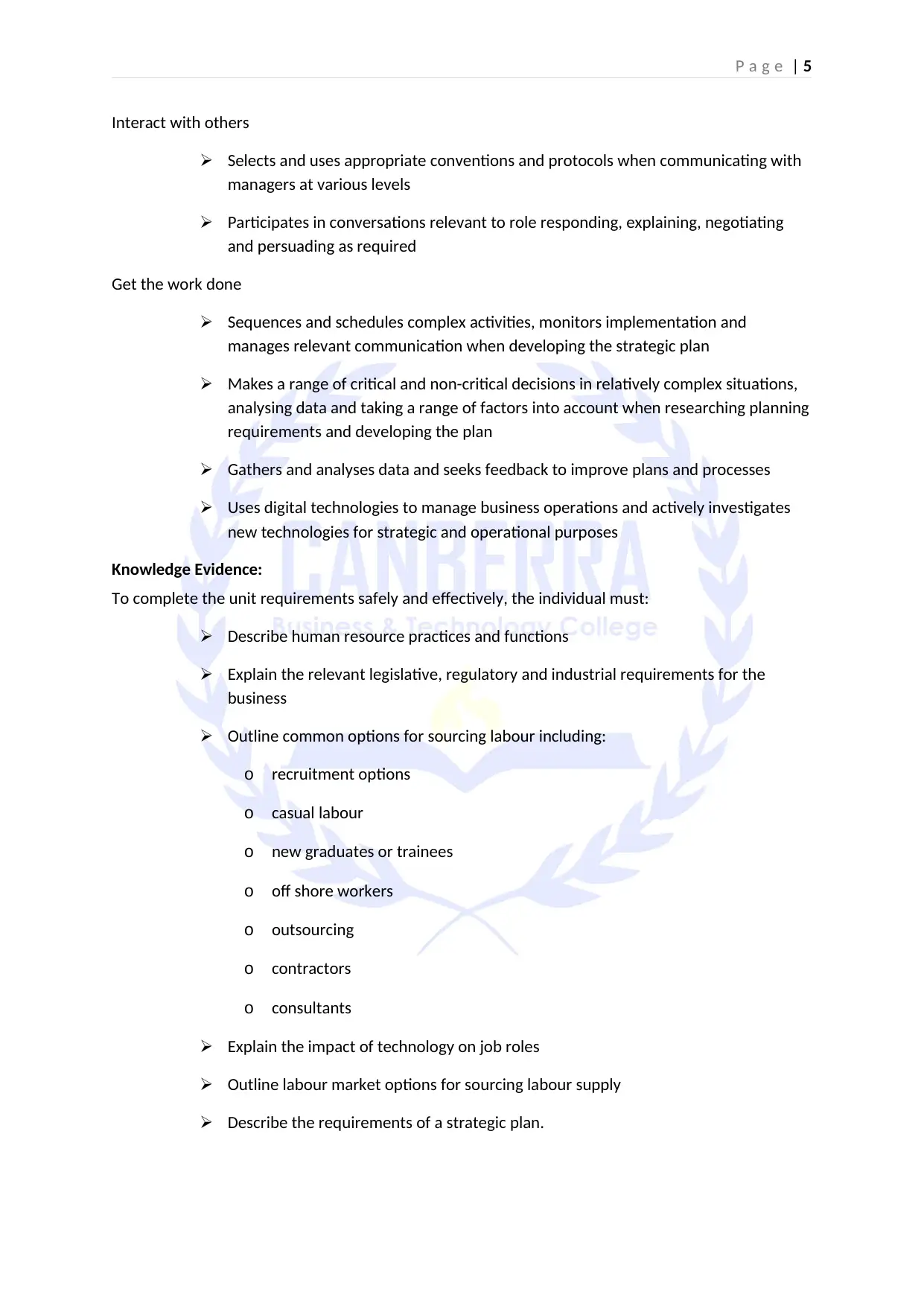
P a g e | 5
Interact with others
Selects and uses appropriate conventions and protocols when communicating with
managers at various levels
Participates in conversations relevant to role responding, explaining, negotiating
and persuading as required
Get the work done
Sequences and schedules complex activities, monitors implementation and
manages relevant communication when developing the strategic plan
Makes a range of critical and non-critical decisions in relatively complex situations,
analysing data and taking a range of factors into account when researching planning
requirements and developing the plan
Gathers and analyses data and seeks feedback to improve plans and processes
Uses digital technologies to manage business operations and actively investigates
new technologies for strategic and operational purposes
Knowledge Evidence:
To complete the unit requirements safely and effectively, the individual must:
Describe human resource practices and functions
Explain the relevant legislative, regulatory and industrial requirements for the
business
Outline common options for sourcing labour including:
o recruitment options
o casual labour
o new graduates or trainees
o off shore workers
o outsourcing
o contractors
o consultants
Explain the impact of technology on job roles
Outline labour market options for sourcing labour supply
Describe the requirements of a strategic plan.
Interact with others
Selects and uses appropriate conventions and protocols when communicating with
managers at various levels
Participates in conversations relevant to role responding, explaining, negotiating
and persuading as required
Get the work done
Sequences and schedules complex activities, monitors implementation and
manages relevant communication when developing the strategic plan
Makes a range of critical and non-critical decisions in relatively complex situations,
analysing data and taking a range of factors into account when researching planning
requirements and developing the plan
Gathers and analyses data and seeks feedback to improve plans and processes
Uses digital technologies to manage business operations and actively investigates
new technologies for strategic and operational purposes
Knowledge Evidence:
To complete the unit requirements safely and effectively, the individual must:
Describe human resource practices and functions
Explain the relevant legislative, regulatory and industrial requirements for the
business
Outline common options for sourcing labour including:
o recruitment options
o casual labour
o new graduates or trainees
o off shore workers
o outsourcing
o contractors
o consultants
Explain the impact of technology on job roles
Outline labour market options for sourcing labour supply
Describe the requirements of a strategic plan.
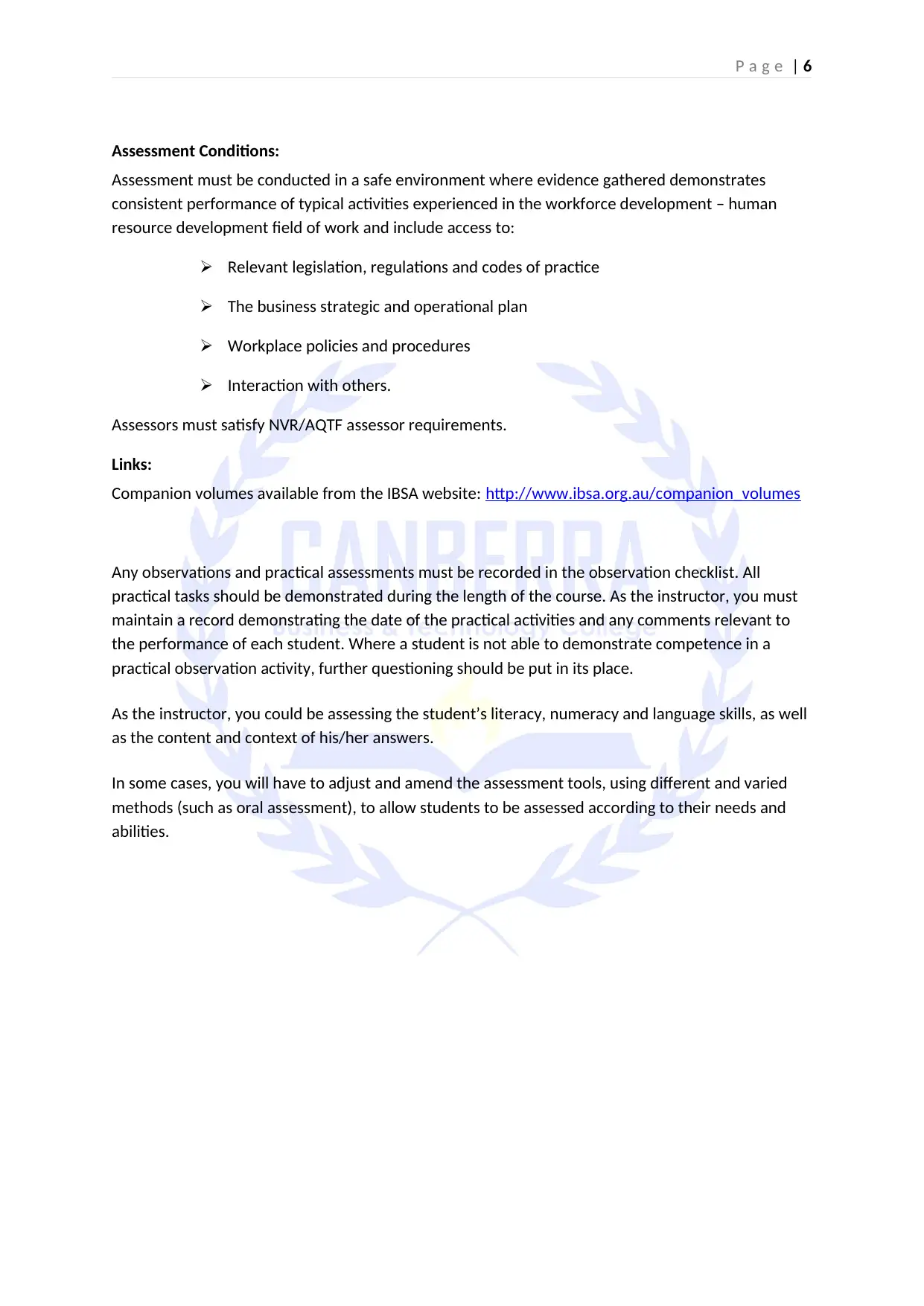
P a g e | 6
Assessment Conditions:
Assessment must be conducted in a safe environment where evidence gathered demonstrates
consistent performance of typical activities experienced in the workforce development – human
resource development field of work and include access to:
Relevant legislation, regulations and codes of practice
The business strategic and operational plan
Workplace policies and procedures
Interaction with others.
Assessors must satisfy NVR/AQTF assessor requirements.
Links:
Companion volumes available from the IBSA website: http://www.ibsa.org.au/companion_volumes
Any observations and practical assessments must be recorded in the observation checklist. All
practical tasks should be demonstrated during the length of the course. As the instructor, you must
maintain a record demonstrating the date of the practical activities and any comments relevant to
the performance of each student. Where a student is not able to demonstrate competence in a
practical observation activity, further questioning should be put in its place.
As the instructor, you could be assessing the student’s literacy, numeracy and language skills, as well
as the content and context of his/her answers.
In some cases, you will have to adjust and amend the assessment tools, using different and varied
methods (such as oral assessment), to allow students to be assessed according to their needs and
abilities.
Assessment Conditions:
Assessment must be conducted in a safe environment where evidence gathered demonstrates
consistent performance of typical activities experienced in the workforce development – human
resource development field of work and include access to:
Relevant legislation, regulations and codes of practice
The business strategic and operational plan
Workplace policies and procedures
Interaction with others.
Assessors must satisfy NVR/AQTF assessor requirements.
Links:
Companion volumes available from the IBSA website: http://www.ibsa.org.au/companion_volumes
Any observations and practical assessments must be recorded in the observation checklist. All
practical tasks should be demonstrated during the length of the course. As the instructor, you must
maintain a record demonstrating the date of the practical activities and any comments relevant to
the performance of each student. Where a student is not able to demonstrate competence in a
practical observation activity, further questioning should be put in its place.
As the instructor, you could be assessing the student’s literacy, numeracy and language skills, as well
as the content and context of his/her answers.
In some cases, you will have to adjust and amend the assessment tools, using different and varied
methods (such as oral assessment), to allow students to be assessed according to their needs and
abilities.
⊘ This is a preview!⊘
Do you want full access?
Subscribe today to unlock all pages.

Trusted by 1+ million students worldwide
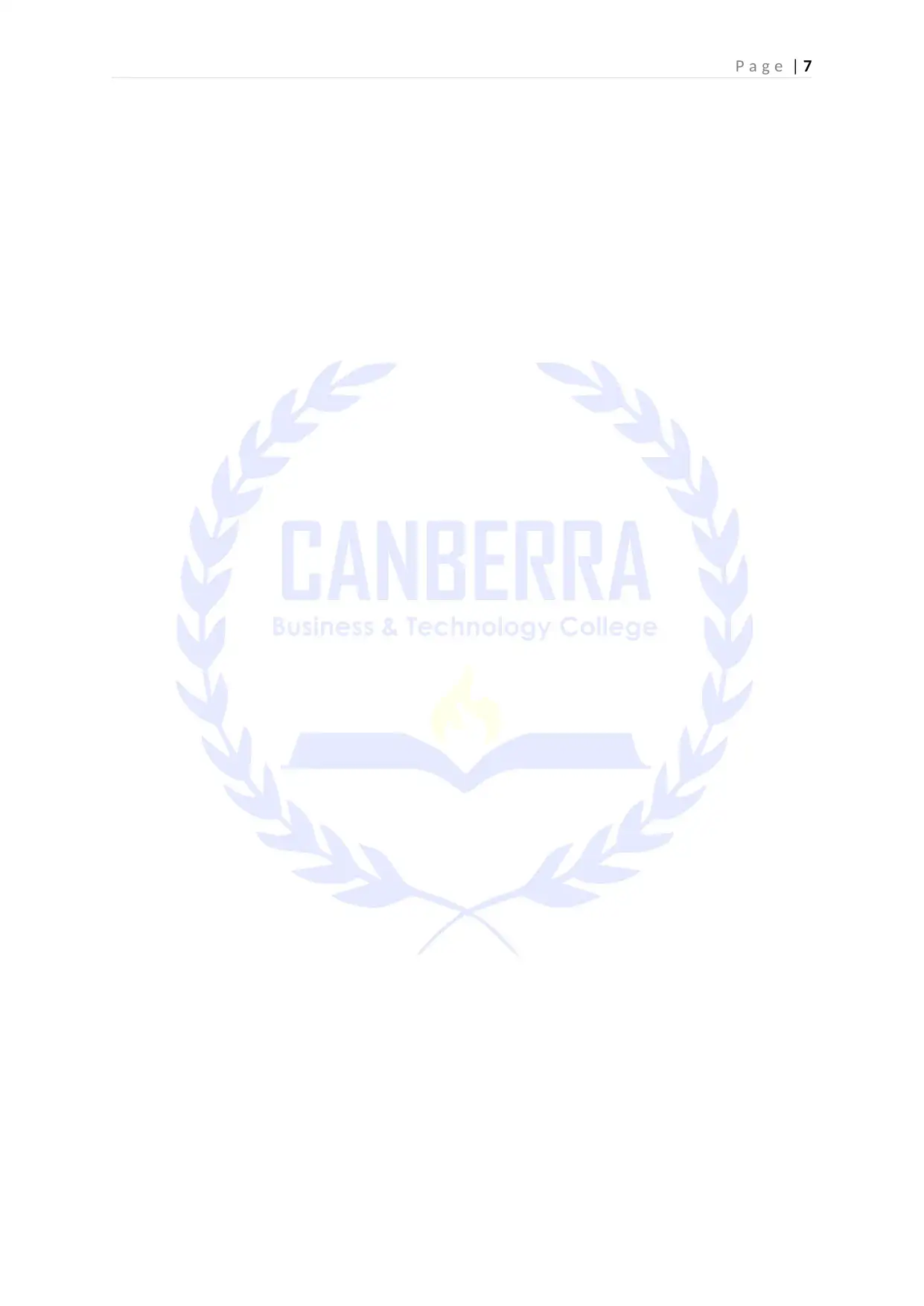
P a g e | 7
Paraphrase This Document
Need a fresh take? Get an instant paraphrase of this document with our AI Paraphraser
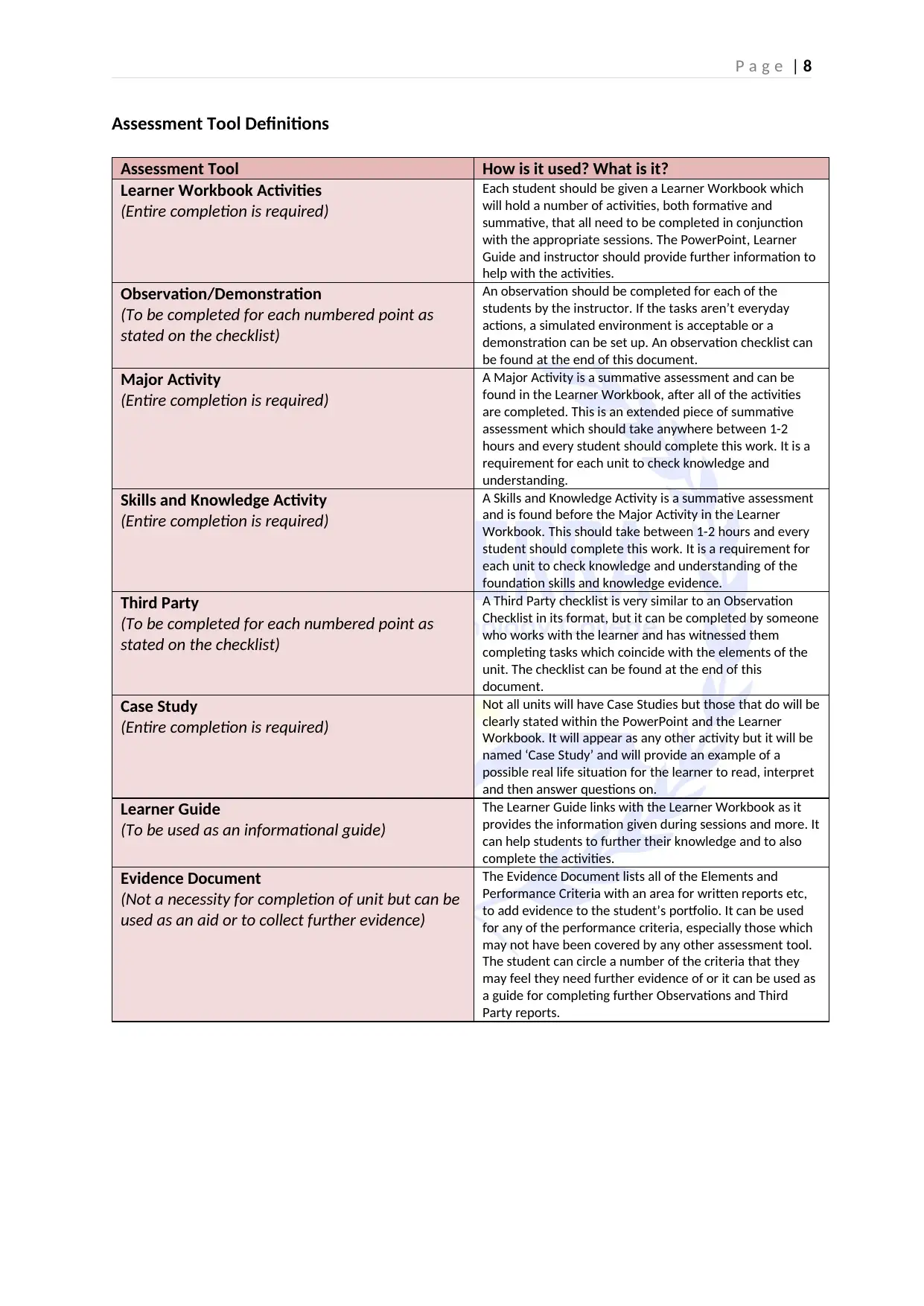
P a g e | 8
Assessment Tool Definitions
Assessment Tool How is it used? What is it?
Learner Workbook Activities
(Entire completion is required)
Each student should be given a Learner Workbook which
will hold a number of activities, both formative and
summative, that all need to be completed in conjunction
with the appropriate sessions. The PowerPoint, Learner
Guide and instructor should provide further information to
help with the activities.
Observation/Demonstration
(To be completed for each numbered point as
stated on the checklist)
An observation should be completed for each of the
students by the instructor. If the tasks aren’t everyday
actions, a simulated environment is acceptable or a
demonstration can be set up. An observation checklist can
be found at the end of this document.
Major Activity
(Entire completion is required)
A Major Activity is a summative assessment and can be
found in the Learner Workbook, after all of the activities
are completed. This is an extended piece of summative
assessment which should take anywhere between 1-2
hours and every student should complete this work. It is a
requirement for each unit to check knowledge and
understanding.
Skills and Knowledge Activity
(Entire completion is required)
A Skills and Knowledge Activity is a summative assessment
and is found before the Major Activity in the Learner
Workbook. This should take between 1-2 hours and every
student should complete this work. It is a requirement for
each unit to check knowledge and understanding of the
foundation skills and knowledge evidence.
Third Party
(To be completed for each numbered point as
stated on the checklist)
A Third Party checklist is very similar to an Observation
Checklist in its format, but it can be completed by someone
who works with the learner and has witnessed them
completing tasks which coincide with the elements of the
unit. The checklist can be found at the end of this
document.
Case Study
(Entire completion is required)
Not all units will have Case Studies but those that do will be
clearly stated within the PowerPoint and the Learner
Workbook. It will appear as any other activity but it will be
named ‘Case Study’ and will provide an example of a
possible real life situation for the learner to read, interpret
and then answer questions on.
Learner Guide
(To be used as an informational guide)
The Learner Guide links with the Learner Workbook as it
provides the information given during sessions and more. It
can help students to further their knowledge and to also
complete the activities.
Evidence Document
(Not a necessity for completion of unit but can be
used as an aid or to collect further evidence)
The Evidence Document lists all of the Elements and
Performance Criteria with an area for written reports etc,
to add evidence to the student’s portfolio. It can be used
for any of the performance criteria, especially those which
may not have been covered by any other assessment tool.
The student can circle a number of the criteria that they
may feel they need further evidence of or it can be used as
a guide for completing further Observations and Third
Party reports.
Assessment Tool Definitions
Assessment Tool How is it used? What is it?
Learner Workbook Activities
(Entire completion is required)
Each student should be given a Learner Workbook which
will hold a number of activities, both formative and
summative, that all need to be completed in conjunction
with the appropriate sessions. The PowerPoint, Learner
Guide and instructor should provide further information to
help with the activities.
Observation/Demonstration
(To be completed for each numbered point as
stated on the checklist)
An observation should be completed for each of the
students by the instructor. If the tasks aren’t everyday
actions, a simulated environment is acceptable or a
demonstration can be set up. An observation checklist can
be found at the end of this document.
Major Activity
(Entire completion is required)
A Major Activity is a summative assessment and can be
found in the Learner Workbook, after all of the activities
are completed. This is an extended piece of summative
assessment which should take anywhere between 1-2
hours and every student should complete this work. It is a
requirement for each unit to check knowledge and
understanding.
Skills and Knowledge Activity
(Entire completion is required)
A Skills and Knowledge Activity is a summative assessment
and is found before the Major Activity in the Learner
Workbook. This should take between 1-2 hours and every
student should complete this work. It is a requirement for
each unit to check knowledge and understanding of the
foundation skills and knowledge evidence.
Third Party
(To be completed for each numbered point as
stated on the checklist)
A Third Party checklist is very similar to an Observation
Checklist in its format, but it can be completed by someone
who works with the learner and has witnessed them
completing tasks which coincide with the elements of the
unit. The checklist can be found at the end of this
document.
Case Study
(Entire completion is required)
Not all units will have Case Studies but those that do will be
clearly stated within the PowerPoint and the Learner
Workbook. It will appear as any other activity but it will be
named ‘Case Study’ and will provide an example of a
possible real life situation for the learner to read, interpret
and then answer questions on.
Learner Guide
(To be used as an informational guide)
The Learner Guide links with the Learner Workbook as it
provides the information given during sessions and more. It
can help students to further their knowledge and to also
complete the activities.
Evidence Document
(Not a necessity for completion of unit but can be
used as an aid or to collect further evidence)
The Evidence Document lists all of the Elements and
Performance Criteria with an area for written reports etc,
to add evidence to the student’s portfolio. It can be used
for any of the performance criteria, especially those which
may not have been covered by any other assessment tool.
The student can circle a number of the criteria that they
may feel they need further evidence of or it can be used as
a guide for completing further Observations and Third
Party reports.
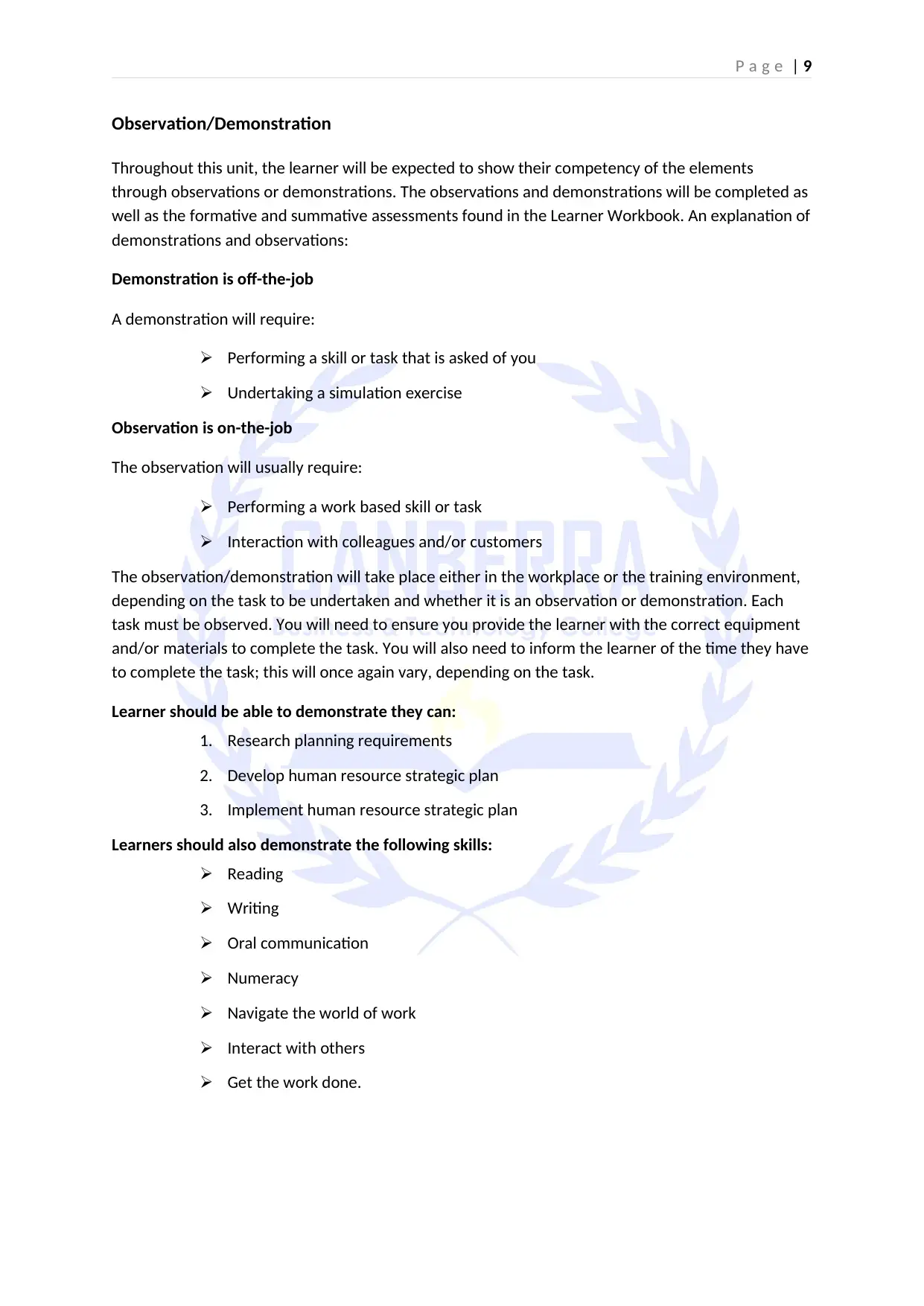
P a g e | 9
Observation/Demonstration
Throughout this unit, the learner will be expected to show their competency of the elements
through observations or demonstrations. The observations and demonstrations will be completed as
well as the formative and summative assessments found in the Learner Workbook. An explanation of
demonstrations and observations:
Demonstration is off-the-job
A demonstration will require:
Performing a skill or task that is asked of you
Undertaking a simulation exercise
Observation is on-the-job
The observation will usually require:
Performing a work based skill or task
Interaction with colleagues and/or customers
The observation/demonstration will take place either in the workplace or the training environment,
depending on the task to be undertaken and whether it is an observation or demonstration. Each
task must be observed. You will need to ensure you provide the learner with the correct equipment
and/or materials to complete the task. You will also need to inform the learner of the time they have
to complete the task; this will once again vary, depending on the task.
Learner should be able to demonstrate they can:
1. Research planning requirements
2. Develop human resource strategic plan
3. Implement human resource strategic plan
Learners should also demonstrate the following skills:
Reading
Writing
Oral communication
Numeracy
Navigate the world of work
Interact with others
Get the work done.
Observation/Demonstration
Throughout this unit, the learner will be expected to show their competency of the elements
through observations or demonstrations. The observations and demonstrations will be completed as
well as the formative and summative assessments found in the Learner Workbook. An explanation of
demonstrations and observations:
Demonstration is off-the-job
A demonstration will require:
Performing a skill or task that is asked of you
Undertaking a simulation exercise
Observation is on-the-job
The observation will usually require:
Performing a work based skill or task
Interaction with colleagues and/or customers
The observation/demonstration will take place either in the workplace or the training environment,
depending on the task to be undertaken and whether it is an observation or demonstration. Each
task must be observed. You will need to ensure you provide the learner with the correct equipment
and/or materials to complete the task. You will also need to inform the learner of the time they have
to complete the task; this will once again vary, depending on the task.
Learner should be able to demonstrate they can:
1. Research planning requirements
2. Develop human resource strategic plan
3. Implement human resource strategic plan
Learners should also demonstrate the following skills:
Reading
Writing
Oral communication
Numeracy
Navigate the world of work
Interact with others
Get the work done.
⊘ This is a preview!⊘
Do you want full access?
Subscribe today to unlock all pages.

Trusted by 1+ million students worldwide
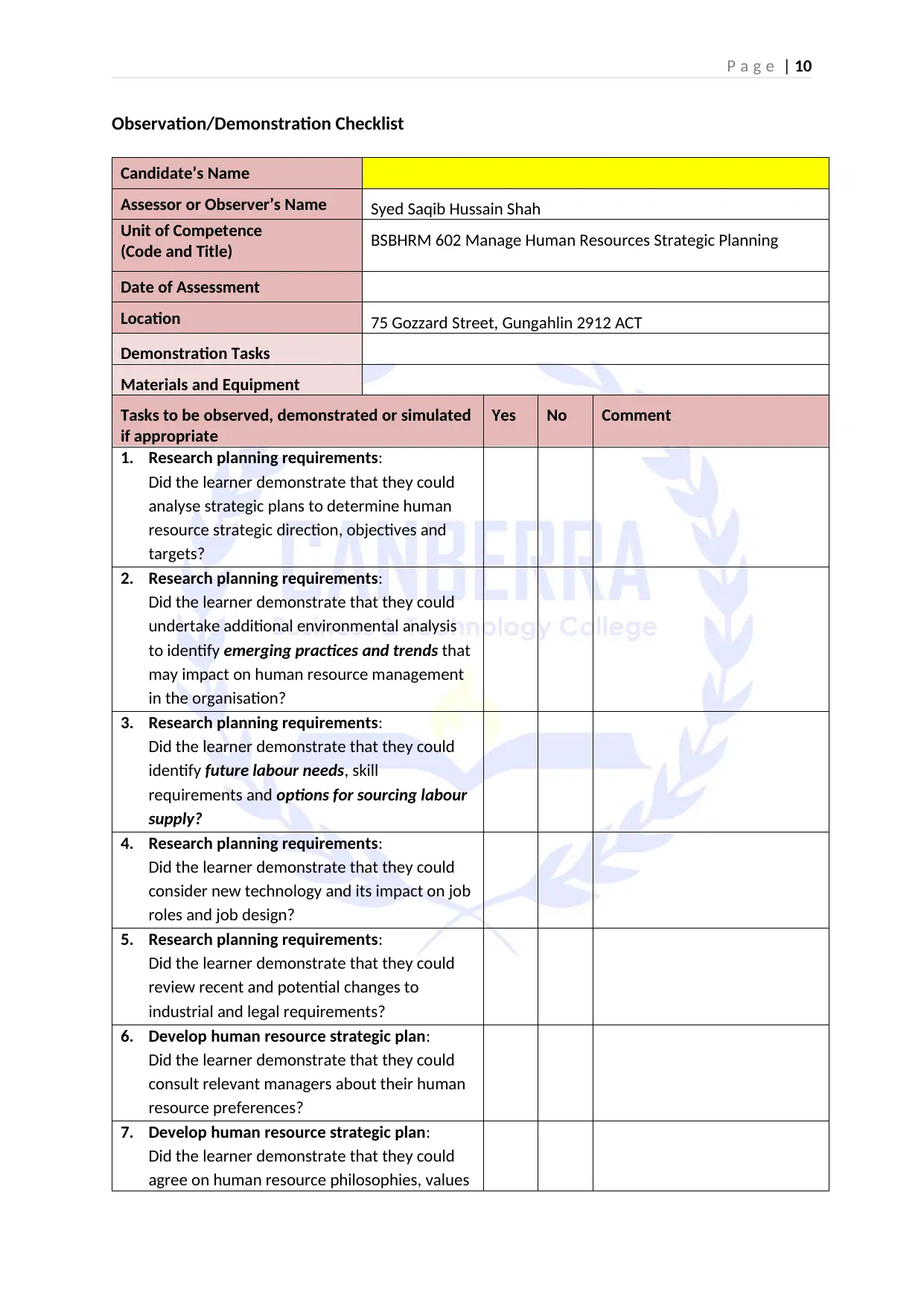
P a g e | 10
Observation/Demonstration Checklist
Candidate’s Name
Assessor or Observer’s Name Syed Saqib Hussain Shah
Unit of Competence
(Code and Title) BSBHRM 602 Manage Human Resources Strategic Planning
Date of Assessment
Location 75 Gozzard Street, Gungahlin 2912 ACT
Demonstration Tasks
Materials and Equipment
Tasks to be observed, demonstrated or simulated
if appropriate
Yes No Comment
1. Research planning requirements:
Did the learner demonstrate that they could
analyse strategic plans to determine human
resource strategic direction, objectives and
targets?
2. Research planning requirements:
Did the learner demonstrate that they could
undertake additional environmental analysis
to identify emerging practices and trends that
may impact on human resource management
in the organisation?
3. Research planning requirements:
Did the learner demonstrate that they could
identify future labour needs, skill
requirements and options for sourcing labour
supply?
4. Research planning requirements:
Did the learner demonstrate that they could
consider new technology and its impact on job
roles and job design?
5. Research planning requirements:
Did the learner demonstrate that they could
review recent and potential changes to
industrial and legal requirements?
6. Develop human resource strategic plan:
Did the learner demonstrate that they could
consult relevant managers about their human
resource preferences?
7. Develop human resource strategic plan:
Did the learner demonstrate that they could
agree on human resource philosophies, values
Observation/Demonstration Checklist
Candidate’s Name
Assessor or Observer’s Name Syed Saqib Hussain Shah
Unit of Competence
(Code and Title) BSBHRM 602 Manage Human Resources Strategic Planning
Date of Assessment
Location 75 Gozzard Street, Gungahlin 2912 ACT
Demonstration Tasks
Materials and Equipment
Tasks to be observed, demonstrated or simulated
if appropriate
Yes No Comment
1. Research planning requirements:
Did the learner demonstrate that they could
analyse strategic plans to determine human
resource strategic direction, objectives and
targets?
2. Research planning requirements:
Did the learner demonstrate that they could
undertake additional environmental analysis
to identify emerging practices and trends that
may impact on human resource management
in the organisation?
3. Research planning requirements:
Did the learner demonstrate that they could
identify future labour needs, skill
requirements and options for sourcing labour
supply?
4. Research planning requirements:
Did the learner demonstrate that they could
consider new technology and its impact on job
roles and job design?
5. Research planning requirements:
Did the learner demonstrate that they could
review recent and potential changes to
industrial and legal requirements?
6. Develop human resource strategic plan:
Did the learner demonstrate that they could
consult relevant managers about their human
resource preferences?
7. Develop human resource strategic plan:
Did the learner demonstrate that they could
agree on human resource philosophies, values
Paraphrase This Document
Need a fresh take? Get an instant paraphrase of this document with our AI Paraphraser
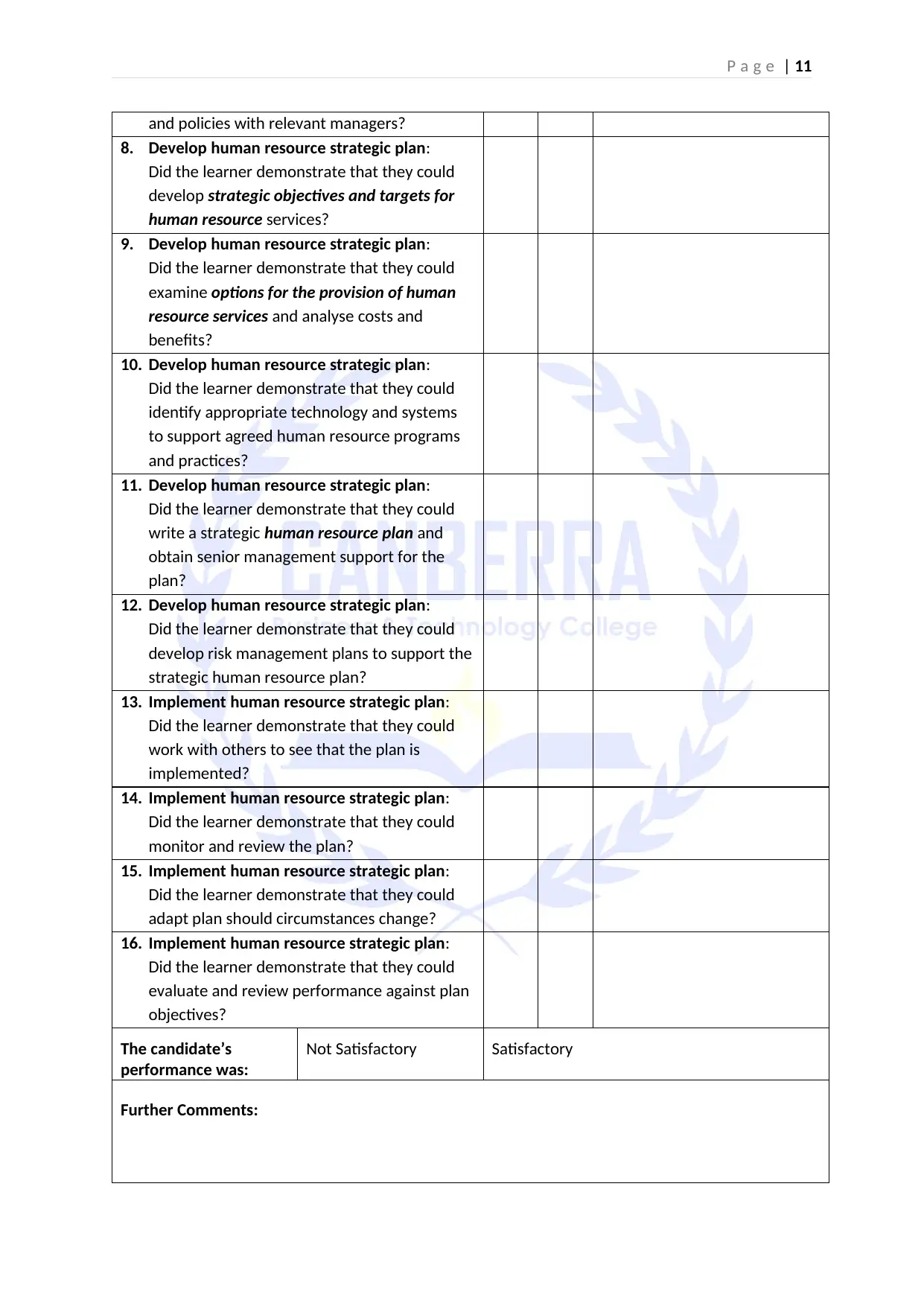
P a g e | 11
and policies with relevant managers?
8. Develop human resource strategic plan:
Did the learner demonstrate that they could
develop strategic objectives and targets for
human resource services?
9. Develop human resource strategic plan:
Did the learner demonstrate that they could
examine options for the provision of human
resource services and analyse costs and
benefits?
10. Develop human resource strategic plan:
Did the learner demonstrate that they could
identify appropriate technology and systems
to support agreed human resource programs
and practices?
11. Develop human resource strategic plan:
Did the learner demonstrate that they could
write a strategic human resource plan and
obtain senior management support for the
plan?
12. Develop human resource strategic plan:
Did the learner demonstrate that they could
develop risk management plans to support the
strategic human resource plan?
13. Implement human resource strategic plan:
Did the learner demonstrate that they could
work with others to see that the plan is
implemented?
14. Implement human resource strategic plan:
Did the learner demonstrate that they could
monitor and review the plan?
15. Implement human resource strategic plan:
Did the learner demonstrate that they could
adapt plan should circumstances change?
16. Implement human resource strategic plan:
Did the learner demonstrate that they could
evaluate and review performance against plan
objectives?
The candidate’s
performance was:
Not Satisfactory Satisfactory
Further Comments:
and policies with relevant managers?
8. Develop human resource strategic plan:
Did the learner demonstrate that they could
develop strategic objectives and targets for
human resource services?
9. Develop human resource strategic plan:
Did the learner demonstrate that they could
examine options for the provision of human
resource services and analyse costs and
benefits?
10. Develop human resource strategic plan:
Did the learner demonstrate that they could
identify appropriate technology and systems
to support agreed human resource programs
and practices?
11. Develop human resource strategic plan:
Did the learner demonstrate that they could
write a strategic human resource plan and
obtain senior management support for the
plan?
12. Develop human resource strategic plan:
Did the learner demonstrate that they could
develop risk management plans to support the
strategic human resource plan?
13. Implement human resource strategic plan:
Did the learner demonstrate that they could
work with others to see that the plan is
implemented?
14. Implement human resource strategic plan:
Did the learner demonstrate that they could
monitor and review the plan?
15. Implement human resource strategic plan:
Did the learner demonstrate that they could
adapt plan should circumstances change?
16. Implement human resource strategic plan:
Did the learner demonstrate that they could
evaluate and review performance against plan
objectives?
The candidate’s
performance was:
Not Satisfactory Satisfactory
Further Comments:
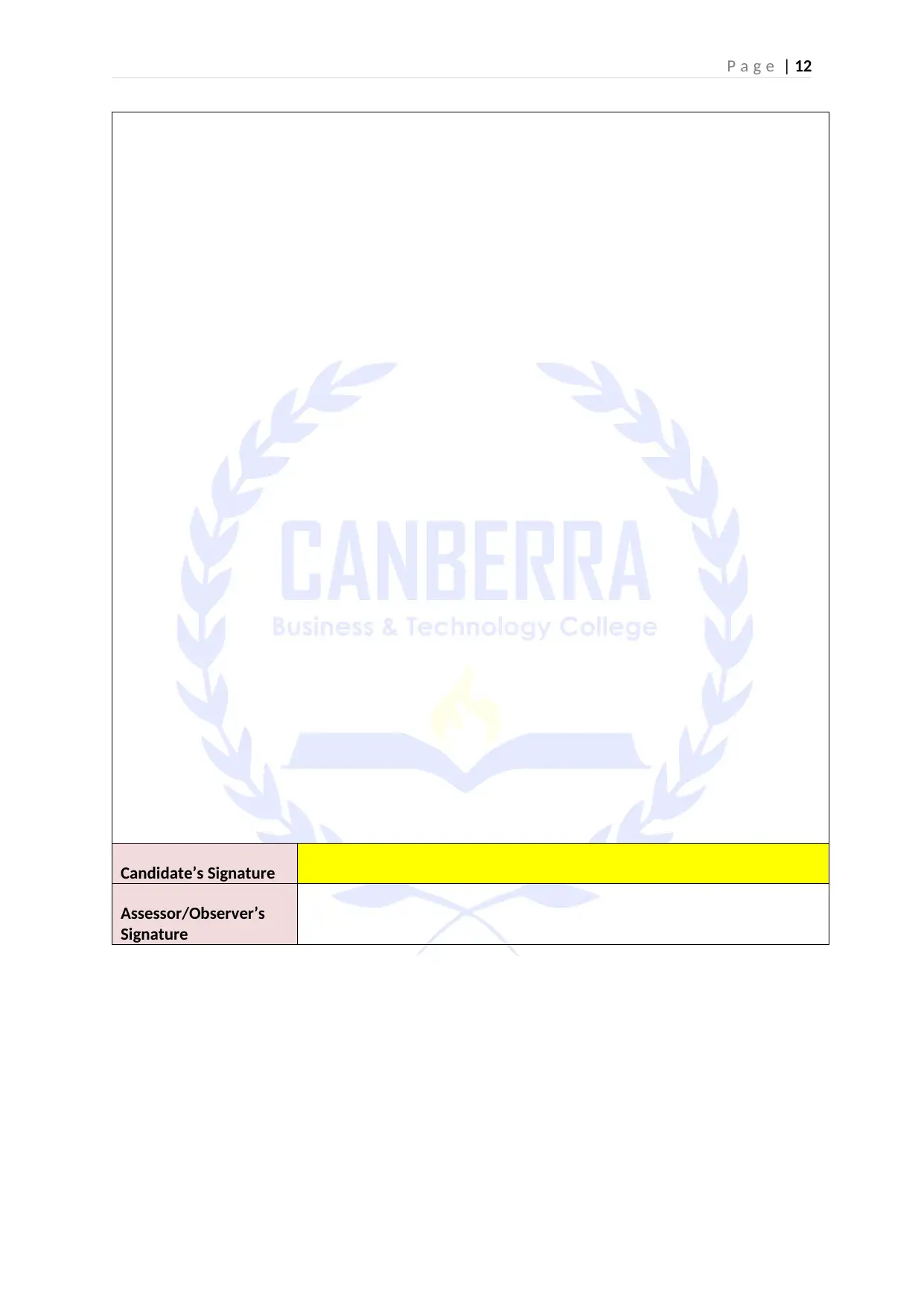
P a g e | 12
Candidate’s Signature
Assessor/Observer’s
Signature
Candidate’s Signature
Assessor/Observer’s
Signature
⊘ This is a preview!⊘
Do you want full access?
Subscribe today to unlock all pages.

Trusted by 1+ million students worldwide
1 out of 57
Related Documents
Your All-in-One AI-Powered Toolkit for Academic Success.
+13062052269
info@desklib.com
Available 24*7 on WhatsApp / Email
![[object Object]](/_next/static/media/star-bottom.7253800d.svg)
Unlock your academic potential
Copyright © 2020–2025 A2Z Services. All Rights Reserved. Developed and managed by ZUCOL.





